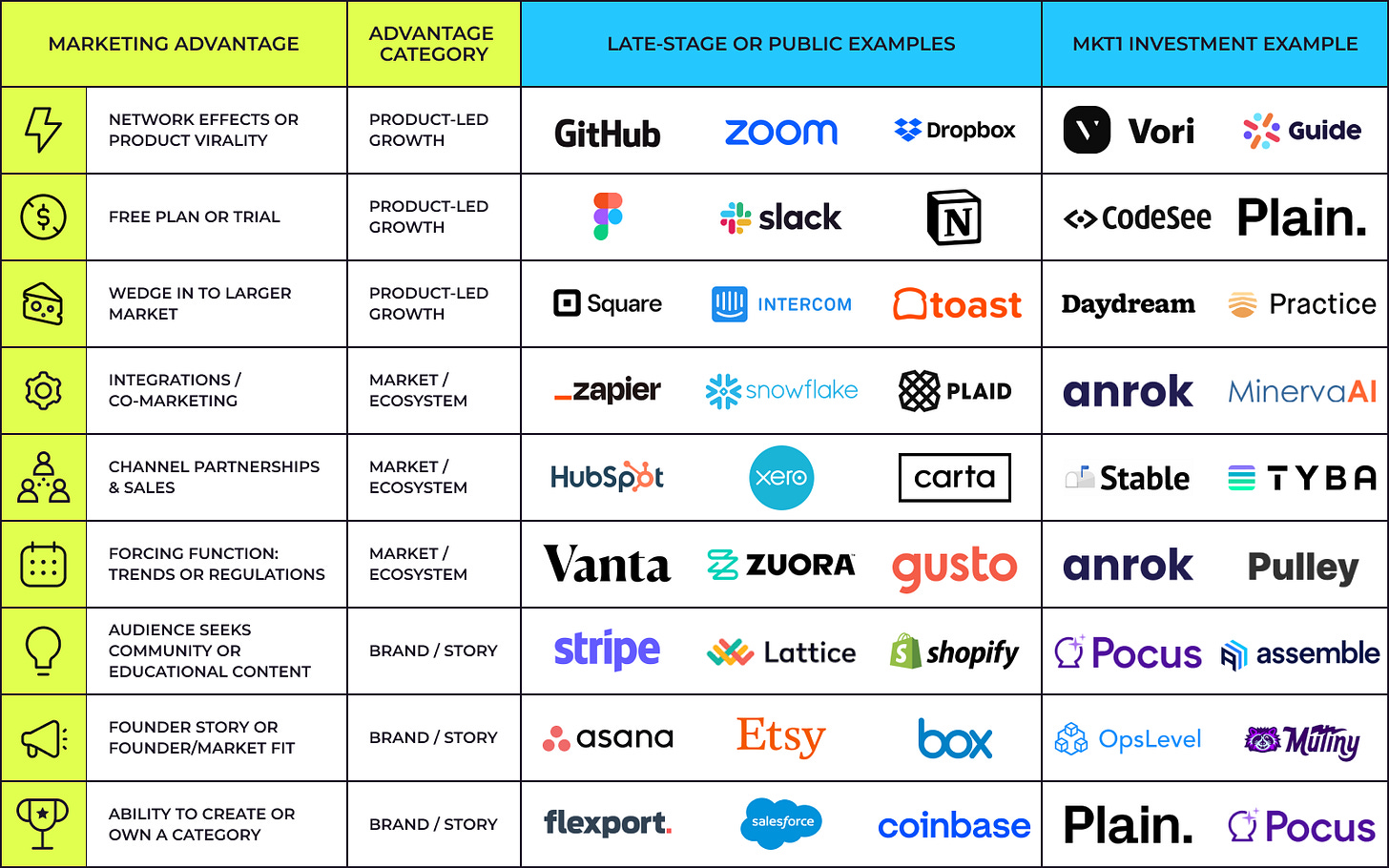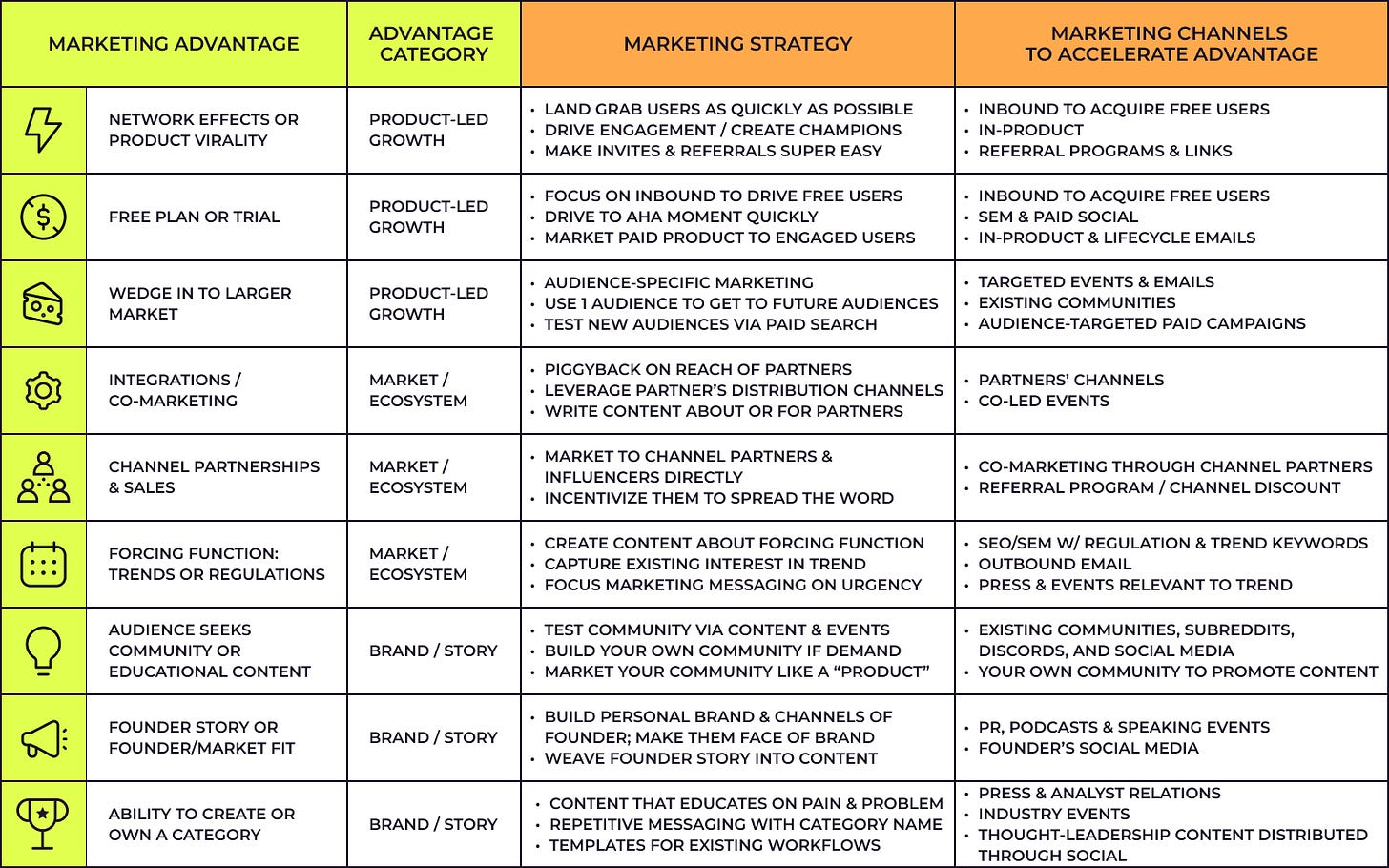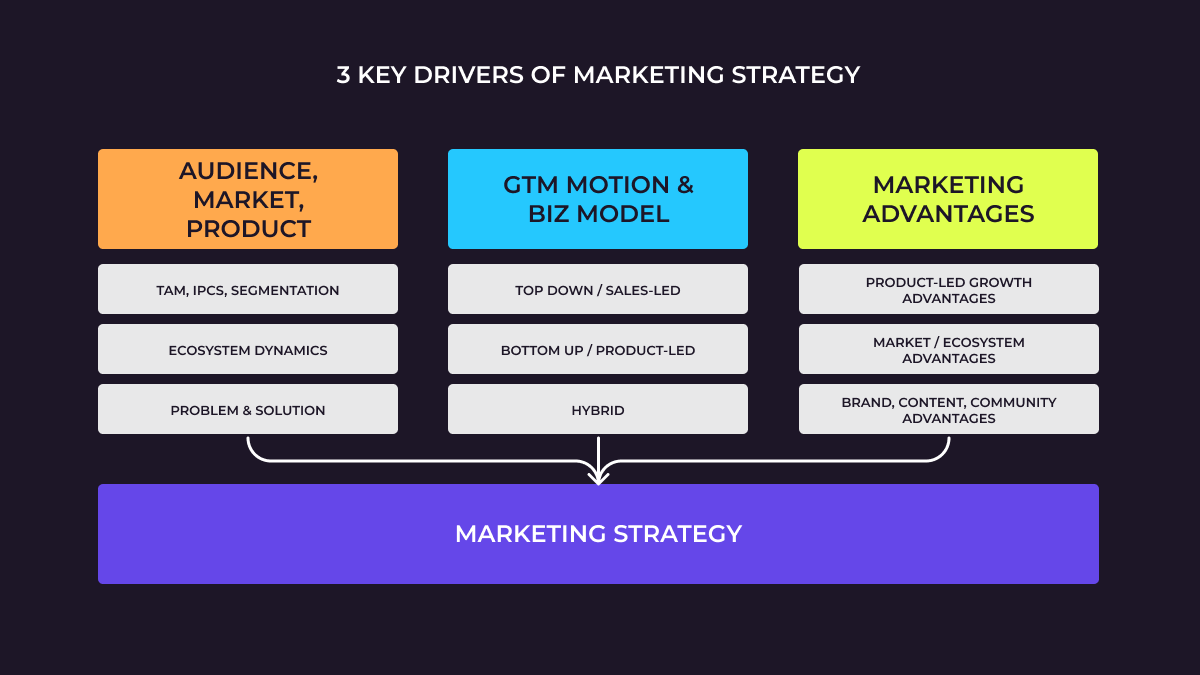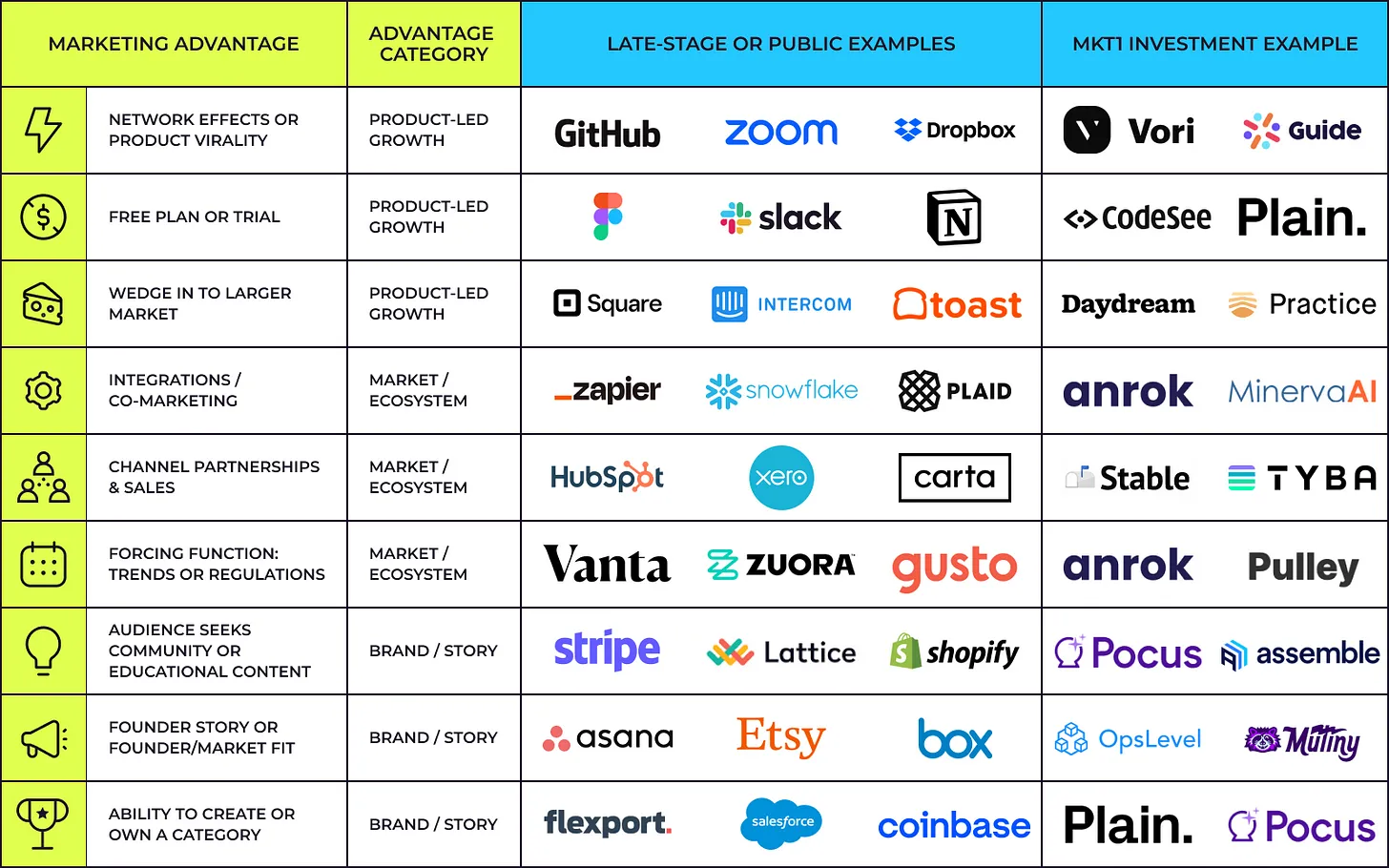A great product, team, and market have become table stakes requirements for startups to succeed. With the proliferation of B2B startups and the lower barriers to building great products, marketing is now the differentiator.
To succeed at startup marketing, a company needs 3 things:
- Founders who approach marketing as a strategic lever, not as a service organization to sales. Founders need to value and enable marketing as they do other teams in the organization. As the company scales, it is critical that all leaders see marketing on equal footing with other teams.
- A team with go-to-market skillsets & storytelling ability. Early on, founders need to be able to effectively hire go-to-market talent, including the right first marketer. The team needs to identify and evolve their marketing fuel (story, messaging, design) and marketing engine (distribution, channels, growth levers) based on their audience, market, and product differentiators.
- Built-in marketing advantages. Marketing advantages are dynamics in a company’s business, product, or market that inherently drive growth. Examples include network effects, category creation, and regulations—and 6 more below.
Marketing advantages = highly critical to a startup’s overall success
When your startup has marketing advantages, first you need to recognize them, then you need to throw fuel on these fires. You definitely should not sit on these goldmines, but instead build on them.
This is crucial because your startup simply can’t win without marketing advantages. And if your startup doesn’t have marketing advantages, you need to adjust your product, your business strategy, or your go-to-market approach.
This newsletter deep dives on marketing advantages. I’ll cover how to identify them, examples of B2B startups and public companies by marketing advantage, and how to build a strategy and marketing plan around your advantages.
But first, we are going to take a brief pause to tell you about our fund—which was built entirely around the thesis that startups who have marketing advantages—and accelerate them—are way more likely to win.
Introducing MKT1 Capital
Today, we announced our first fund in TechCrunch. MKT1 Capital is a $10M early-stage B2B fund started by former marketing leaders Emily Kramer (Asana, Carta)—that’s me—and Kathleen Estreich (Box, Intercom, Scalyr). We are currently raising our 2nd tranche of capital, and invite you to invest. We have a reduced minimum for marketers—and already have over 50 marketers as investors.
For more on our first fund, and how you can invest, jump on over to our fund announcement post (to spare your inbox, it will not be sent out to subscribers).

Identifying marketing advantages
When you know what to look for, you’ll spot marketing advantages regularly, especially in high-growth late stage and public companies. The most successful startups typically have more than one marketing advantage they actively leverage. For example, Figma not only falls into the “free plan” category below, but also has network effects, a thriving community, and lots of integrations and creators that help drive growth.
Marketing advantages are best illustrated by examples, so I spent way too long making this chart (but I think it was worth it?):

Marketing advantage definitions
Marketing advantages can be broken down into 3 categories, based on what’s driving the advantage: Product-led growth advantages, Market / ecosystem advantages, and brand advantages. In all cases, it is marketing’s job to accelerate the advantage.
Here’s how we define each advantage:
Product-led growth marketing advantages
⚡NETWORK EFFECTS OR PRODUCT VIRALITY
Virality: When users share your product—internally or externally.
Network effects: When a product gains more value when more people use it–which tends to be a stronger advantage than virality alone.
🤑 FREE PLAN OR TRIAL
When your product has a free version that helps users unlock value faster before purchasing, it typically makes your product easier to market and sell. This is especially true when you have the right “trigger” to convert a company to paid (whether that’s time, user count, or feature based). If you have a self-serve motion for new customers or self-serve upgrade process, even without a free product, this can also be an advantage—but usually to a lesser extent.
🧀 WEDGE INTO A LARGER MARKET
When your product and GTM efforts initially target a small segment with a goal of ultimately winning a larger market, you have a wedge in. A wedge in can mean expanding from one audience to additional audiences with the same or slightly different product, or building a specific product for an audience and expanding to become a full-platform or suite of products for that audience.
This is only a marketing advantage if you use your first wedge, both on the product side and the marketing side, to get to the next. Otherwise, you’ll be starting from scratch each time you launch to a new wedge, and you’ll never scale fast enough (this advantage then goes from being an advantage to a disadvantage).
Market / Ecosystem marketing advantages
⚙️ INTEGRATIONS / CO-MARKETING
When your product or business has obvious partners, you have potential for co-marketing opportunities. If you work with partners to leverage each others’ distribution channels or piggyback on their brand awareness, you can grow faster than by building your own audience. You can even piggyback on a “partner’s” audience by writing content about them or segmenting marketing to their user base, without working with the partner directly.
🧑🤝🧑 CHANNEL PARTNERSHIPS & SALES
When you make it easy for other players in your ecosystem to promote or sell your product for a share of revenue, a referral bonus, or a discount for the buyer, you unlock growth. It’s essential to enable your channel partners by properly incentivizing them and helping them market your product. Channel partners can even be influencers or service providers in your ecosystem.
🗓️ FORCING FUNCTION: TRENDS OR REGULATIONS
Forcing functions create urgency to buy. When there is a current trend in the market (like the downturn) you can piggyback on, your messaging will better resonate. Even better than being relevant to a trend, new or changing regulations are incredibly strong forcing functions.
Brand & story marketing advantages
💡 AUDIENCE SEEKS COMMUNITY OR EDUCATIONAL CONTENT
When your audience is underserved by educational content or opportunities to connect with each other, you have an opportunity to fill this gap. When you treat your community and content like a “product” to drive top-of-funnel growth this advantage becomes stronger.
📣 FOUNDER STORY OR FOUNDER/MARKET FIT
If your founder already has relationships or a personal brand built up with your target audience, it’s easier to gain credibility with prospects and customers. In addition to helping build credibility, you can use founders with existing followings as distribution channels. To make this a true marketing advantage though, you need a founder who can and wants to effectively tell this story.
🏆 ABILITY TO CREATE OR OWN A CATEGORY
When your product is an entirely new space and doesn’t replace an existing product, you have an opportunity to brand a whole new way of doing something. If your brand becomes synonymous with the category, you have a huge leg up on the competition. Similarly, you can redefine an existing category with new criteria or try to be crowned the winner in an emerging category created by another brand or by analysts.
Not every business should create a new category, it can be extremely time consuming. Creating a category is only an advantage when you are truly doing something new, and aren’t just building 5x-10x better version of an existing product.
You can create new advantages, but don’t force it
Sometimes, these advantages are super obvious, as they are core to your product and business. In some cases, you may not have the advantage yet, but you can create these advantages, and the benefit of having one of these advantages is worth the investment to get there (think launching a free plan). Other advantages are hard to force—like your founding story or ability to create a category–and you can waste a lot of time trying to make this happen when it isn’t natural.
How to adapt your marketing strategy to your marketing advantages
Build a strategy and select tactics that work for your marketing advantage. Based on your marketing advantage, certain “fuel” (content, messaging, and design) will be more effective and certain channels will work better.

Here are some semi-obvious examples of how to adapt your marketing strategy to your marketing advantages:
- If you are targeting a niche audience as a wedge-in, don’t wait for everyone to come inbound, you know who your audience is, go find them at events or in communities or add all of the accounts and contacts to your CRM and run outbound campaigns.
- On the flip side, if you have a large audience and a free plan that converts well, go broad with your efforts to drive inbound and see how people use your product. Later you can mix in ABM campaigns to the most successful types of customers.
- If developers build on your platform already, build marketing relationships with those developers too and enable them to market your product.
- If you have a story that basically writes itself and a founder with 100K Twitter followers, you should probably lean into your brand advantage–unless Elon Musk is your CEO.
Here are some of my favorite examples of marketing advantages, that might not be quite as obvious:
- Work with, not against, service providers or agencies: Imagine your company is an accounting product selling to finance teams at startups, instead of trying to replace all of the work of the actual accountant, use accounting firms that already work with startups to market for you. Incentivize accounting firms to use your product with their clients or refer your product to their clients with a referral bonus or discount.
This strategy can work for audiences that rely on agencies or external consultants to get their job done (e.g. a website hosting platform like Webflow using web agencies, a legal tech startup using lawyers, a construction tech startup using general contractors, etc) - Highlight cross-functional use cases to get from one audience to the next: Let’s say your business is a horizontal project management tool (like Asana hypothetically), start marketing to one audience, say product. Make a best-in-class experience for them. Promote use cases to your core audience that involve other teams. In this example, you could promote a “product launches project” use case—which involves marketing, support, sales, etc. Now use the product team to help you get marketing teams on board for that one use case. Now that marketers are on the platform, expand their use cases. Keep doing this.
- Leverage the pull of community: You may be creating so much content that your audience is already chatting about this content on social media or in existing communities. It’s natural to then start a Slack group for these people. This can then turn into a larger community that drives customer acquisition and loyalty. Even though communities are trendy right now and can be huge growth drivers, don’t create a community just for the sake of it. Before starting a community, make sure you have this “pull” from your audience and you have content or “fuel” to drive it.
- Add a self-serve motion and later a free product: If your company has a top-down sales model, you may be able to “unlock” a marketing advantage by testing a self-serve flow. This isn’t a fit for all businesses, but if you see that some deals are closing super fast–in 24 to 48 hours—your audience is probably eager and ready to buy from the time they hit your website. You can “test” a self-serve motion by adding chat to your website and selling via chat before you build the whole flow. If this works, potentially build a free product too.
Selecting channels that fit with your marketing advantages
You now hopefully understand how your marketing strategy should be set around your advantages. You realize you shouldn’t try to fit a square peg in a round hole.
For each marketing advantage, there are also a set of channels that are typically best. There are details in the chart above, but at a high level, here are the channels I recommend:
- Product-led growth: To acquire new users, test organic and paid inbound channels and double down on what’s working. But keep marketing to users throughout their lifecycle to drive engagement, upgrades, and virality—make them your champions. Use owned channels like email, help content, onboarding, and your product to do this.
- Market/Ecosystem: Leverage partners, whether that be customers, companies with integrations, agencies or consultants, or other ecosystem players to help you create content and distribute it through their channels.
- Brand/story: Create content that ladders up to your overall story and distribute, distribute, distribute—especially through your own community if you have one.
Don’t build your marketing strategy off another company’s playbook
Instead, play to your startup’s strengths to grow much faster. And don’t just build a strategy around your marketing advantages…make sure to also factor in your audience, market and product, plus your GTM motion and business model to create your strategy.
A huge mistake I see from founders and marketers who have spent a long time at one company, and even experienced marketing leaders who have worked at a handful of startups: Trying to copy and paste a marketing strategy from another company.
Since the combination of the below 3 inputs is never the same across companies, following another company’s exact playbook will never work.

Speaking of GTM motions, I’m doing an AMA with Pocus tomorrow on how your business model impacts your marketing strategy. RSVP here.
To wrap it up…
Learning to identify marketing advantages helps founders identify their early marketing strategy, helps marketers find the right levers for growth, and helps candidates select startups that can succeed. Without marketing advantages, you won’t win.
